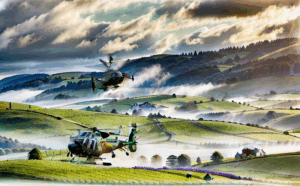Residents across Perth and Kinross, as well as the wider Tayside and Fife regions, can expect to witness an increased presence of Chinook helicopters in the skies over the coming fortnight. These large military aircraft are part of an extensive training exercise that commenced this week, involving low-altitude flights across the area.
The distinctive twin-rotor helicopters have already been observed in various locations, with sightings reported from as far west as Tulliallan Police College on Monday. Subsequently, these formidable machines made appearances at Dundee Airport and Leuchars Aerodrome, signifying the broad geographical scope of the exercise. A recent video, captured on Tuesday afternoon, provided a striking visual of one such Chinook taking off from Dundee Airport, showcasing its immense power and maneuverability. Understanding the Military Drills
This increased aerial activity is part of a comprehensive three-week military training programme, which includes not only low-flying helicopter operations but also the audible sounds of gunfire from specific training zones. While the presence of military aircraft is a regular occurrence, the intensity and duration of this particular exercise have prompted a public advisory to ensure local awareness.
Key areas within Perth and Kinross, specifically around Crieff, are designated as active training grounds, along with Kirriemuir in Angus. Crews participating in these drills originate from RAF Benson, located in Oxfordshire, and will be temporarily stationed at Leuchars Aerodrome until August 29. This extended deployment underscores the significance of Leuchars as a strategic base for such large-scale military preparations. Safety and Awareness for Local Communities
In light of the low-flying nature of these exercises, specific guidance has been issued by RAF Lossiemouth to ensure public safety, particularly for those engaging in outdoor activities. Horse riders, for instance, have been strongly advised to wear high-visibility clothing. This measure is crucial for pilots to easily identify them from the air, allowing adjustments to flight paths to avoid unnecessary low passes over equestrians and their horses, minimizing potential disturbance or risk.
The exercise aims to foster inter-service collaboration, with participating teams from the Royal Air Force, British Army, and Royal Navy working in concert. Such joint operations are vital for maintaining readiness and demonstrating seamless coordination across different branches of the armed forces. The Versatile Chinook: A Closer Look
For those unfamiliar with the aircraft, the Chinook is renowned as a highly versatile support helicopter. Its design allows it to operate effectively from a variety of platforms, including land bases and naval vessels, and in diverse and challenging environments ranging from the Arctic tundra to scorching deserts and dense jungles.
Primary roles of the Chinook include the swift transportation of troops, the resupply of essential provisions to frontline units, and the critical evacuation of casualties from battlefields. Its impressive payload capacity means it can carry approximately 55 fully equipped troops or up to 10 tonnes of mixed cargo. Visually, the Chinook is easily identifiable by its unique tandem rotor configuration, featuring two large counter-rotating rotor blades that contribute to its exceptional lift capabilities and stability in flight.
As the exercise continues, local communities in Perth and Kinross are encouraged to remain informed and follow any further advisories issued by military authorities, understanding that these drills are a critical component of national defence and readiness.
The distinctive twin-rotor helicopters have already been observed in various locations, with sightings reported from as far west as Tulliallan Police College on Monday. Subsequently, these formidable machines made appearances at Dundee Airport and Leuchars Aerodrome, signifying the broad geographical scope of the exercise. A recent video, captured on Tuesday afternoon, provided a striking visual of one such Chinook taking off from Dundee Airport, showcasing its immense power and maneuverability. Understanding the Military Drills
This increased aerial activity is part of a comprehensive three-week military training programme, which includes not only low-flying helicopter operations but also the audible sounds of gunfire from specific training zones. While the presence of military aircraft is a regular occurrence, the intensity and duration of this particular exercise have prompted a public advisory to ensure local awareness.
Key areas within Perth and Kinross, specifically around Crieff, are designated as active training grounds, along with Kirriemuir in Angus. Crews participating in these drills originate from RAF Benson, located in Oxfordshire, and will be temporarily stationed at Leuchars Aerodrome until August 29. This extended deployment underscores the significance of Leuchars as a strategic base for such large-scale military preparations. Safety and Awareness for Local Communities
In light of the low-flying nature of these exercises, specific guidance has been issued by RAF Lossiemouth to ensure public safety, particularly for those engaging in outdoor activities. Horse riders, for instance, have been strongly advised to wear high-visibility clothing. This measure is crucial for pilots to easily identify them from the air, allowing adjustments to flight paths to avoid unnecessary low passes over equestrians and their horses, minimizing potential disturbance or risk.
The exercise aims to foster inter-service collaboration, with participating teams from the Royal Air Force, British Army, and Royal Navy working in concert. Such joint operations are vital for maintaining readiness and demonstrating seamless coordination across different branches of the armed forces. The Versatile Chinook: A Closer Look
For those unfamiliar with the aircraft, the Chinook is renowned as a highly versatile support helicopter. Its design allows it to operate effectively from a variety of platforms, including land bases and naval vessels, and in diverse and challenging environments ranging from the Arctic tundra to scorching deserts and dense jungles.
Primary roles of the Chinook include the swift transportation of troops, the resupply of essential provisions to frontline units, and the critical evacuation of casualties from battlefields. Its impressive payload capacity means it can carry approximately 55 fully equipped troops or up to 10 tonnes of mixed cargo. Visually, the Chinook is easily identifiable by its unique tandem rotor configuration, featuring two large counter-rotating rotor blades that contribute to its exceptional lift capabilities and stability in flight.
As the exercise continues, local communities in Perth and Kinross are encouraged to remain informed and follow any further advisories issued by military authorities, understanding that these drills are a critical component of national defence and readiness.


